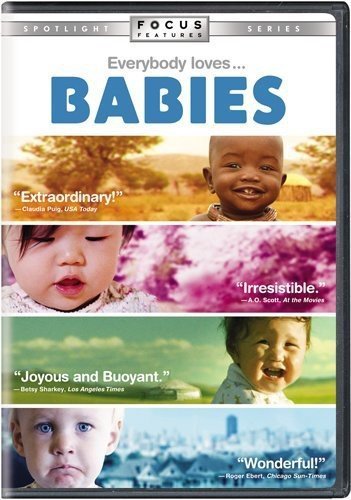About this item
Experience joy and happiness at its purest in this life-affirming, universal celebration of the magic and innocence of Babies. Proving that if you surround your baby with love it doesnt matter what culture youre from or what child-rearing practices you follow. Babies travels the globe following four children from vastly different corners of the world - Ponijao from Namibia, Bayarjargal from Mongolia, Mari from Tokyo and Hattie from San Francisco. Sure to put a smile on your face and a warm feeling in your heart, its the film that critics and audiences agree "could be the feel-good movie of the decade!" (Moviefone)
AMAZON.COM
The babies in Babies are four newborns, photographed in their natural habitat in distinctly different parts of the world. Hattie is in San Francisco, Maris in Tokyo, Baryarjargal lives out in the Mongolian steppes, and Ponijao is born amid the simple straw huts of Namibia. In the course of less than 80 minutes, were going to follow this quartet through their first year of life, a chronicle that director Thomas Balmes and producer Alain Chabat have likened to a nature documentary that happens to focus on humans. We can cut to the chase here and say that above and beyond any sociological weight this project might possess, this films main method can be summed up in the words of David Byrne and Talking Heads from the song "Stay Up Late": "See him drink / From a bottle / See him eat / From a plate / Cute cute / As a button /Dont you want to make him stay up late." In short, babies are cute, babies are funny, and a camera focused on a baby is going to catch the sudden mood shifts and clunky crawling and all the other ingredients of home movies. Along the way, we may pause to notice the cultural differences between the locales, as the American baby seems elaborately nurtured (maybe baby yoga classes could wait a year?) and the African baby views a world just as full of wonder and newness as anywhere else, despite the material poverty of the locale. The Namibia and Mongolia sequences are certainly more arresting than the two urban sections, because their backdrops are so dramatically unusual to most Western eyes. If those differences are colorful, the movie nevertheless suggests that babies are more alike in their development than they are different. Is this enough to qualify as a movie? Well, even if Babies really is little more than a collection of sure-fire infant cuteness, itll probably be enough for its target audience. --Robert Horton
Learn more on imdb
Learn more on MovieDB


